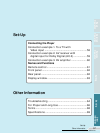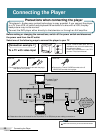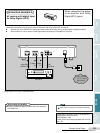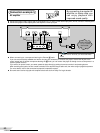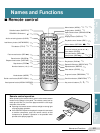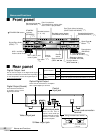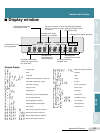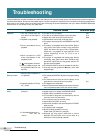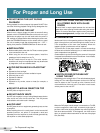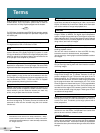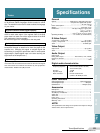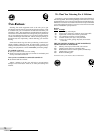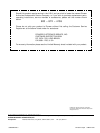
68
<VRB1210>
Terms
Terms
Dolby digital (AC-3)*
Dolby Digital(AC-3) delivers up to 5.1 channels of discrete multi-
channel audio. This is the same system that is used for
surround sound in Dolby Digital equipped movie theaters.
For DVD discs, the digital output PCM/Ÿ jack (coaxial or optical)
must be connected to the amplifier or processor’s digital input
AC-3/PCM jack.
PCM
PCM stands for Pulse Code Modulation and is digital audio.
The digital audio of CD or DVD discs is PCM.
DTS
DTS stands for Digital Theater System. DTS is a surround
system different to the Dolby Digital (AC-3) system. In order
to enjoy the benefits of DTS discs, the digital output jack (either
coaxial or optical) of this player needs to be connected to the
DTS input jack of an amplifier or processor.
MPEG
Short for Moving Picture Experts Group. This is an international
standard for compression of moving images. On some DVDs
digital audio has been compressed and recorded in this format.
Title number
Title numbers refer to titles of movies etc. As DVD discs have
a large capacity, many movies can be recorded on one disc.
For example, when 3 different movies are recorded on a disc,
they are divided into TITLE 1, TITLE 2 and TITLE 3. Playback
can be operated by selecting the title number.
Chapter number
Chapter numbers are the numbers assigned to sections on a
title of the disc, similar to chapters in a book. If the disc includes
these numbers, you can locate the section you want very
quickly using chapter search and other functions.
Time number
The time number is the playback lapse time of a title in the
disc from its beginning. The scene you want to locate can be
searched for with the time number using the time number
function etc..
Playback Control (PBC)
This refers to signals recorded on a Video CD (Version 2.0)
enabling playback control.
You can use menus recorded on discs with PBC for easy,
interactive search for desired scenes, and playback.
You can also enjoy viewing high-resolution/standard resolution
still images.
High-resolution images
If the high-resolution still images are recorded on the Video
CD, you can enjoy viewing them with four times the resolution
of moving images.
Multi-angle
When you watch regular TV programs you are watching the
image filmed through the TV camera. Because of this the
picture is displayed on your TV from the view point of the TV
camera’s position. In a TV studio the image is filmed by many
cameras at the same time, and one of those images is selected
by the program director and transmitted to your TV. If all the
filmed images were transmitted to your TV you would be able
to select the camera image you want. Some DVD discs are
recorded with the angles of all camera’s used for filming and
these can be selected using this player. These types of discs
are called multi-angle discs.
Aspect
Aspect ratio refers to the length to height ratio of TV screens.
The ratio of a normal TV is 4:3, while the ratio of a Hi-vision TV
or wide TV is 16:9. This allows you to enjoy a picture with a
wider perspective.
Parental level
This function was suggested by parents. Parental level
restrictions are restrictions incorporated into scenes that
parents do not wish their children to view.
Condition memory
“Condition” refers to the various mode settings etc. On this
player, various conditions, such as those set during playback
etc. can be memorized. This function allows you to play back
the same disc at any time without having to reset the condition
settings.
DOLBY
D
I
G
I
T
AL
TOC
TOC (Table Of Contents) information is data other than audio
signal data, recorded at the beginning of a disc. As the name
implies, it’s like the list of contents in a book, with information
such as the number of songs and playback time.
Video CDs
These discs provide MD quality sound, and VHS quality video
images. Thanks to MPEG1, the digital signal compression
system, a single disc provides up to 74 minutes of continuous
digital audio and video. There are also Video CDs with Playback
Control (PBC) that let you select playback of desired scenes
using menus, and view still images.
* Manufactured under license from Dolby Laboratories, “Dolby”,
and the double-D symbol are trademarks of Dolby Laboratories.
Confidential Unpublished Works, © 1992-1997 Dolby Laboratories,
Inc. All right reserved.



